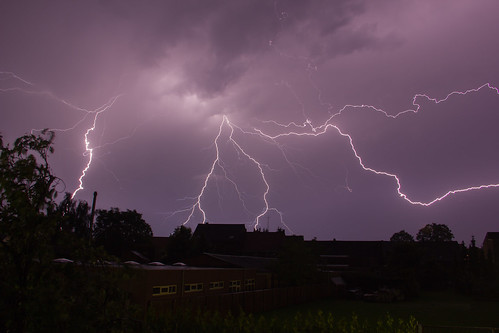 |
| Photo by Paul Dings (Click to see original on Flickr.) |
 |
| Photo by Melissa K. (Click to see original on Flickr.) |
Many fears in dogs can be treated with desensitization, which means reproducing the fearful stimulus in a safe and calm environment. This does not work very well for thunderstorm phobia. You can certainly recreate the sound of thunder and even simulate lightning. However, it is not just these things that cause fear. It is almost impossible to duplicate the rain, wind, changes in the barometric pressure, and changes in the static electric fields. Static electricity may play a large role in the fear since many dogs will try to hide in places that are electrical grounds, such as bathtubs, showers, behind toilet tanks, and against metal radiators or pipes.
What can we do to help our pets during storms? There are actually quite a few things that can help alleviate the fear.
1. Be available and remain calm: Sometimes just being present and staying calm can help. Just remember, our dogs can pick up on our emotions easily so if we get stressed out, that will reinforce their fear. Try to engage your dog in a game with their favorite toy. Provide comfort, but don't coddle them, as that will reward the fearful behavior.
2. Find a safe place: Find someplace in the house that can be used as a safety zone. Ideally, it should be a smaller space with no windows, or a room where the windows can be covered with thick, lined curtains or cardboard. Basements are often the best places. Turn on the lights to help mask the lightning and play classical music. Try to engage your dog in some upbeat interaction, such as play or even leash walking him around the room. A solid sided crate may also help. However, the crate door should remain open. The room should also contain water, food, toys, and treats. At first, you will have to take your dog to the room. After a while, he may head there himself at the first sign of an impending storm.
3. Ant-anxiety attire: There are a few products on the market in this category. The Thunder Shirt and Anxiety Wrap provide light pressure over the dog's body to help him feel secure. It's very similar to swaddling an infant. The Storm Defender also provides an anti-static liner.
4. Natural supplements and remedies: There are many herbal and all natural remedies on the market to reduce fear and anxiety in dogs. Check with your veterinarian before using any of them to make sure it is not contra-indicated with any health issues affecting your dog. There are also pheromone diffusers and collars available. These contain synthetic dog appeasing pheromone, or D.A.P., which dogs naturally release when nursing.
5. Prescription anti-anxiety medications: For some dogs, none of the above recommendations seem to help. In these cases, anti-anxiety medications may be the only thing that can relieve their stress and fear. Many people are reluctant to "drug" their dogs. These medications are not meant to cause sedation and mask the fear, they actually help relieve the stress and fear the dog experiences. If you think your dog may benefit from an anti-anxiety medication, talk to your veterinarian.
Veterinary Practice News, Thunderstorm Phobia in Dogs- An Update, Aug. 18, 2011, Nicholas Dodman, BVMS, Dipl. ACVB DVM 360, Storm Phobias, Sept. 1, 2004, Karen L. Overall, MA, VMD, PhD, Dipl. ACVB, CAAB
Written by Dr. Cindi Worral
Read more or contact Dr. Worral:

Dr. Cindi Worral
Lap of Love Veterinary Hospice
berks@lapoflove.com
www.lapoflove.com
(484) 504-9482
Dr. Worral services Berks County, parts of Western Montgomery County including Pottstown, Collegeville, Lansdale, Norristown, and King of Prussia and parts of Northern Chester County including Coventry, Phoenixville, and Honeybrook Some of Southern Lehigh County, including Macungie, Allentown and Emmaus.

Hi, I was simply checking out this blog and I really admire the premise of the article and this is really informative. I will for sure refer my friends the same. Thanks
ReplyDeletenatural dog products